Malte Lehna
Learning Topology Actions for Power Grid Control: A Graph-Based Soft-Label Imitation Learning Approach
Mar 19, 2025Abstract:The rising proportion of renewable energy in the electricity mix introduces significant operational challenges for power grid operators. Effective power grid management demands adaptive decision-making strategies capable of handling dynamic conditions. With the increase in complexity, more and more Deep Learning (DL) approaches have been proposed to find suitable grid topologies for congestion management. In this work, we contribute to this research by introducing a novel Imitation Learning (IL) approach that leverages soft labels derived from simulated topological action outcomes, thereby capturing multiple viable actions per state. Unlike traditional IL methods that rely on hard labels to enforce a single optimal action, our method constructs soft labels over actions, by leveraging effective actions that prove suitable in resolving grid congestion. To further enhance decision-making, we integrate Graph Neural Networks (GNNs) to encode the structural properties of power grids, ensuring that the topology-aware representations contribute to better agent performance. Our approach significantly outperforms state-of-the-art baselines, all of which use only topological actions, as well as feedforward and GNN-based architectures with hard labels. Most notably, it achieves a 17% better performance compared to the greedy expert agent from which the imitation targets were derived.
Fault Detection for agents on power grid topology optimization: A Comprehensive analysis
Jun 24, 2024



Abstract:The topology optimization of transmission networks using Deep Reinforcement Learning (DRL) has increasingly come into focus. Various researchers have proposed different DRL agents, which are often benchmarked on the Grid2Op environment from the Learning to Run a Power Network (L2RPN) challenges. The environments have many advantages with their realistic chronics and underlying power flow backends. However, the interpretation of agent survival or failure is not always clear, as there are a variety of potential causes. In this work, we focus on the failures of the power grid to identify patterns and detect them a priori. We collect the failed chronics of three different agents on the WCCI 2022 L2RPN environment, totaling about 40k data points. By clustering, we are able to detect five distinct clusters, identifying different failure types. Further, we propose a multi-class prediction approach to detect failures beforehand and evaluate five different models. Here, the Light Gradient-Boosting Machine (LightGBM) shows the best performance, with an accuracy of 86%. It also correctly identifies in 91% of the time failure and survival observations. Finally, we provide a detailed feature importance analysis that identifies critical features and regions in the grid.
HUGO -- Highlighting Unseen Grid Options: Combining Deep Reinforcement Learning with a Heuristic Target Topology Approach
May 01, 2024

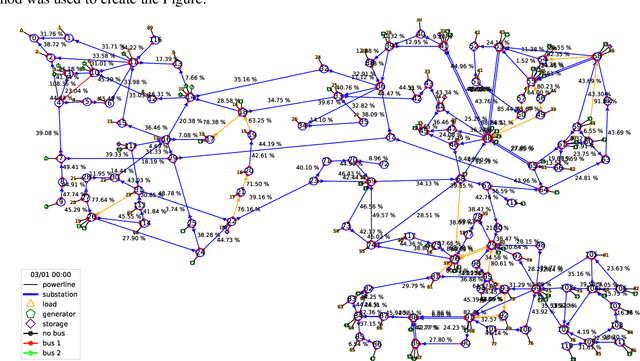
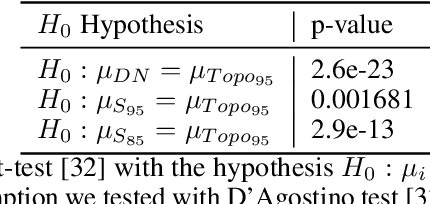
Abstract:With the growth of Renewable Energy (RE) generation, the operation of power grids has become increasingly complex. One solution is automated grid operation, where Deep Reinforcement Learning (DRL) has repeatedly shown significant potential in Learning to Run a Power Network (L2RPN) challenges. However, only individual actions at the substation level have been subjected to topology optimization by most existing DRL algorithms. In contrast, we propose a more holistic approach in this paper by proposing specific Target Topologies (TTs) as actions. These topologies are selected based on their robustness. As part of this paper, we present a search algorithm to find the TTs and upgrade our previously developed DRL agent CurriculumAgent (CAgent) to a novel topology agent. We compare the upgrade to the previous CAgent agent and can increase their scores significantly by 10%. Further, we achieve a 25% better median survival with our TTs included. Later analysis shows that almost all TTs are close to the base topology, explaining their robustness.
Managing power grids through topology actions: A comparative study between advanced rule-based and reinforcement learning agents
Apr 17, 2023
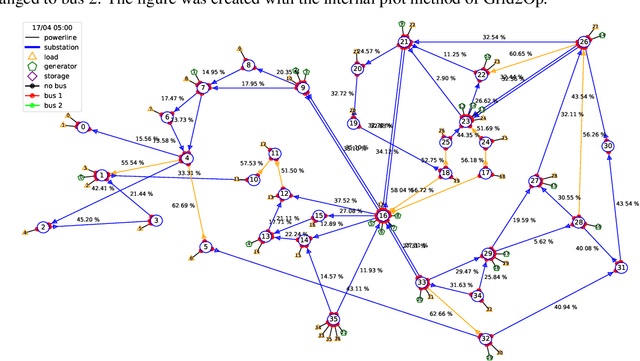

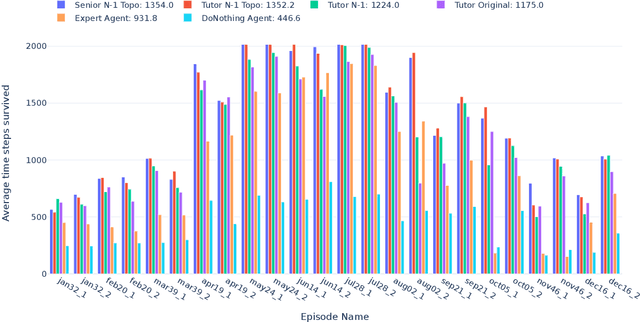
Abstract:The operation of electricity grids has become increasingly complex due to the current upheaval and the increase in renewable energy production. As a consequence, active grid management is reaching its limits with conventional approaches. In the context of the Learning to Run a Power Network challenge, it has been shown that Reinforcement Learning (RL) is an efficient and reliable approach with considerable potential for automatic grid operation. In this article, we analyse the submitted agent from Binbinchen and provide novel strategies to improve the agent, both for the RL and the rule-based approach. The main improvement is a N-1 strategy, where we consider topology actions that keep the grid stable, even if one line is disconnected. More, we also propose a topology reversion to the original grid, which proved to be beneficial. The improvements are tested against reference approaches on the challenge test sets and are able to increase the performance of the rule-based agent by 27%. In direct comparison between rule-based and RL agent we find similar performance. However, the RL agent has a clear computational advantage. We also analyse the behaviour in an exemplary case in more detail to provide additional insights. Here, we observe that through the N-1 strategy, the actions of the agents become more diversified.
Targeted Adversarial Attacks on Wind Power Forecasts
Mar 29, 2023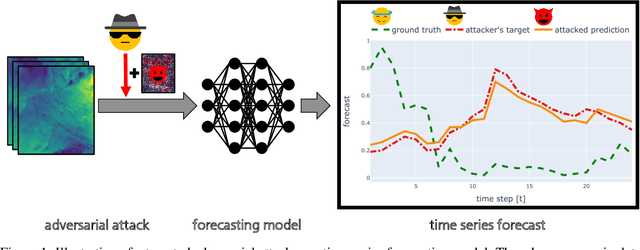

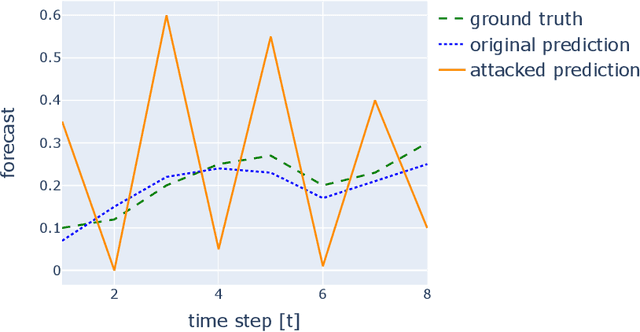

Abstract:In recent years, researchers proposed a variety of deep learning models for wind power forecasting. These models predict the wind power generation of wind farms or entire regions more accurately than traditional machine learning algorithms or physical models. However, latest research has shown that deep learning models can often be manipulated by adversarial attacks. Since wind power forecasts are essential for the stability of modern power systems, it is important to protect them from this threat. In this work, we investigate the vulnerability of two different forecasting models to targeted, semitargeted, and untargeted adversarial attacks. We consider a Long Short-Term Memory (LSTM) network for predicting the power generation of a wind farm and a Convolutional Neural Network (CNN) for forecasting the wind power generation throughout Germany. Moreover, we propose the Total Adversarial Robustness Score (TARS), an evaluation metric for quantifying the robustness of regression models to targeted and semi-targeted adversarial attacks. It assesses the impact of attacks on the model's performance, as well as the extent to which the attacker's goal was achieved, by assigning a score between 0 (very vulnerable) and 1 (very robust). In our experiments, the LSTM forecasting model was fairly robust and achieved a TARS value of over 0.81 for all adversarial attacks investigated. The CNN forecasting model only achieved TARS values below 0.06 when trained ordinarily, and was thus very vulnerable. Yet, its robustness could be significantly improved by adversarial training, which always resulted in a TARS above 0.46.
A Reinforcement Learning Approach for the Continuous Electricity Market of Germany: Trading from the Perspective of a Wind Park Operator
Nov 26, 2021
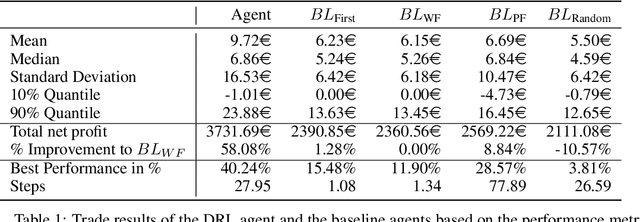


Abstract:With the rising extension of renewable energies, the intraday electricity markets have recorded a growing popularity amongst traders as well as electric utilities to cope with the induced volatility of the energy supply. Through their short trading horizon and continuous nature, the intraday markets offer the ability to adjust trading decisions from the day-ahead market or reduce trading risk in a short-term notice. Producers of renewable energies utilize the intraday market to lower their forecast risk, by modifying their provided capacities based on current forecasts. However, the market dynamics are complex due to the fact that the power grids have to remain stable and electricity is only partly storable. Consequently, robust and intelligent trading strategies are required that are capable to operate in the intraday market. In this work, we propose a novel autonomous trading approach based on Deep Reinforcement Learning (DRL) algorithms as a possible solution. For this purpose, we model the intraday trade as a Markov Decision Problem (MDP) and employ the Proximal Policy Optimization (PPO) algorithm as our DRL approach. A simulation framework is introduced that enables the trading of the continuous intraday price in a resolution of one minute steps. We test our framework in a case study from the perspective of a wind park operator. We include next to general trade information both price and wind forecasts. On a test scenario of German intraday trading results from 2018, we are able to outperform multiple baselines with at least 45.24% improvement, showing the advantage of the DRL algorithm. However, we also discuss limitations and enhancements of the DRL agent, in order to increase the performance in future works.
 Add to Chrome
Add to Chrome Add to Firefox
Add to Firefox Add to Edge
Add to Edge